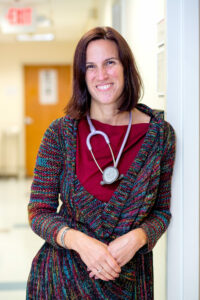
Editor’s note: I recently interviewed Dr. Kirsten Meisinger for Patient Safety Beat, the digital newsletter of the Betsy Lehman Center. In that conversation, she talks about the “National Plan for Health Workforce Well-Being” that was released in October, how teamwork has transformed her practice and the effect that financial pressure has on healthcare.
Danny van Leeuwen, whose “Health Hats” blog and podcast are often featured here, embodies engagement. In the intro to his latest podcast, he emphasizes the richness of patient engagement; done right, it pervades an organization at all levels:
Patients engaged in governance, design, operations, and learning about medical care delivery, policy, research, technology, and business. People at the center of care (patients, direct care clinicians, and the people that support them) sit at decision and learning tables like boards, advisory councils, departmental meetings, product design sessions, insurance company business meetings.
He goes on to say that he is currently most interested in community engagement in health, clarifying that he’s thinking broadly about “Neighborhoods, towns, virtual, diagnosis-based – any kind of community. Communities engaged in best health for their residents and members.”
That’s a segue to his conversation with Kirsten Meisinger, MD, director of provider engagement, regional medical director, medical director of sexual and reproductive health, and operations lead for telehealth at the Cambridge Health Alliance. She is also a family practice physician for CHA in the neighboring town of Somerville and incoming medical staff president at CHA.
It’s a rollicking conversation that conveys the delight of two people discovering what they have in common. To give a flavor of the conversation, I’ll list some of the highlights I especially enjoyed and recommend tuning in by audio or text to enjoy it in full.
- The Cambridge Health Alliance is a community-minded health organization. Based in the vibrant, diverse city of Cambridge, Massachusetts, CHA defines its purpose as “providing expert caring, developing innovative new care models, partnering with the community and advocating for a more just society.” Dr. Meisinger sees CHA’s commitment to and responsibility for its community as its “superpower.” She says public health and primary care work in similar ways to quietly support and enable health:
Because the whole job of public health is to look at the greater good and say, what do we do for the people who live in this place to make sure that they are happier, healthier, and more empowered. It’s that kind of invisible work, a little like primary care, right?
Dr. Meisinger’s commitment to her patients, many of whom came to Massachusetts from Brazil, led her to learn Portuguese. She reports that she now spends most of her work day speaking Portuguese.
- As director of provider engagement, Dr. Meisinger helps CHA understand “What makes us [providers] tick” and how to help people perform at their highest level. She believes that has a lot to do with joy—for providers and patients—and describes a circular system in which engaged, joyful clinicians create conditions that help patients experience joy and empowerment. Prompted by van Leeuwen, she describes patient, provider and community engagement as a three-part collaboration, much like singing a tune in three-part harmony. Deep in conversation, she states the obvious when she says, “I’m quite a happy person, as it turns out.”
- Referring to her primary care office, Dr. Meisinger is aware that employees working at all levels in the organization contribute to community and individual engagement. Everyone should be valued for their individual qualities and the value of the connections they forge, sometimes in surprising ways. As a leader, Dr. Meisinger figures it’s part of her job to remove barriers that prevent people from sharing their passions and connecting with others:
I think where we started…, is a deep love and respect for the patients in patient care. Without that, it’s not something worth having. And everyone in the office has an important part in that. I often say, “We don’t know who patients are going to fall in love with. So let them fall in love just to get it right.” This is where I would say, “Get out of the way.”





